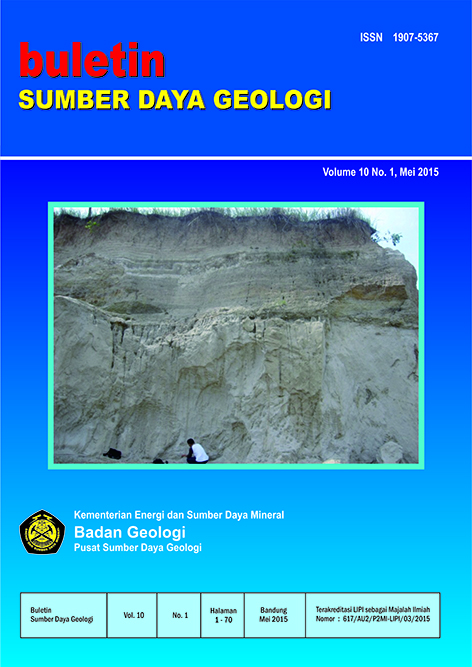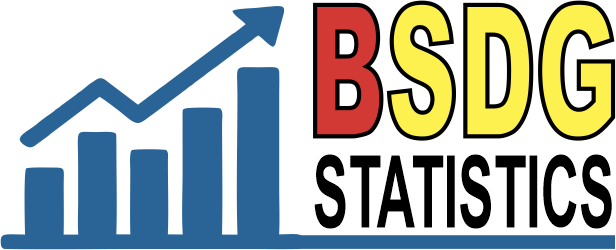TIPE CEBAKAN MINERAL BERDASARKAN DATA GEOKIMIA TANAH DI GUNUNG RAWAN PERBATASAN SARAWAK - KABUPATEN SANGGAU, PROVINSI KALIMANTAN BARAT
Abstract
Gunung Rawan merupakan salah satu titik tapal batas daerah perbatasan antara Malaysia dan Indonesia di Pulau Kalimantan (Borneo). Sebagian daripada gunung tersebut yaitu daerah KedupSarawak sudah diketahui mengandung cebakan emas primer. Zona pemineralan ini diperkirakan menerus ke wilayah Kabupaten Sanggau. Dalam kerangka kerjasama penyelidikan dengan MGMalaysia, Pusat Sumber Daya Geologi melakukan penyelidikan di daerah Gunung Rawan untuk mengetahui penyebaran zona pemineralan tersebut. Litologi di daerah penyelidikan berupa breksi tufa yang umumnya sudah mengalami ubahan silisifikasi, propilitisasi dan argilitisasi dengan jenis mineral ubahan kaolinit, halloysit dan muskovit, mengandung pirit dan kalkopirit. Analisis koefisien korelasi terhadap unsur-unsur Au, As, Sb dan Hg dari geokimia tanah menunjukkan kekerabatan positif yang mencerminkan genesa dalam satu sistim. Terdapat empat kluster anomali unsur yaitu Cu-Hg, Au-SbAs,Hg-Sb dan Cu-Au-As-Ag yang tersebar dominan dalam satuan batuan gunung api. Klaster anomali unsur Cu-Hg dengan pemineralan kalkopirit dan Au-Sb-As dengan pemineralan pirit terkonsentrasi di sekitar puncak Gunung Rawan yang diduga masih berhubungan dengan proses pemineralan yang terjadi di wilayah Kedup, Sarawak. Pemineralan tersebut diduga merupakan tipe epithermal volcanic - hosted.
Downloads
References
Anonim, 2001. Informasi Bahan Galian Tambang Kabupeten Sanggau, Dinas Pertambangan dan Pengendalian Dampak Lingkungan Kabupaten
Sanggau, Pemerintah Daerah Kabupaten Sanggau (tidak terbit).
Anonim, 2012. Laporan Penyelidikan Mineral Logam di daerah Perbatasan MalaysiaKabupaten Sanggau, Provinsi Kalimantan Barat, Pusat Sumber Daya Geologi, Badan Geologi, Kementerian Energi dan Sumber Daya Mineral (tidak terbit).
Anonim, 2014. Laporan Eksplorasi Umum Mineral Logam Mulia dan Logam Dasar di Daerah Perbatasan Malaysia Kabupaten Sanggau Provinsi Kalimantan Barat, Pusat Sumber Daya Geologi, Badan Geologi, Kementerian Energi dan Sumber Daya Mineral (tidak terbit).
Berger,B.R., and Eimon, P.I., 1982. Comparative models of epithermal
silver-gold deposits: AIME Preprint, no. 82-13, SME-AIME Mtg., Dallas, Texas.
Bunchanan, L.J., 1981. Precious Metal Deposis Associated with Volcanic
Environments in the Southwest Arizona. Geological Society Digest, v.
, p. 237-262.
Foit, F.F., and Ulbricht, M.E., 2001. Compositional Variation In Mercurian
Tetrahedrite–Tennantite From The Epithermal Deposits of The Steens And
Pueblo Mountains, Harney County, Oregon, The Canadian Mineralogist Vol. 39, pp. 819-830 .
Giggenbach, W.F., 1992. Isotopic Shifts in Waters from Geothermal and Volcanic Systems along Convergent Plates Boundaries and their Origin : Earth and Planetory Science Letters, v. 118, p. 495-510
Gray, J.E., Gent, C.A., Snee, L.W. and Wilson, W.H., 1997. Epithermal
Mercury-Antimony and Gold-Bearing Vein Lodes of Southwestern Alaska:
Economic Geology, Monograph 9, pp. 287-305
Hedenquist, J.W., Izawa, E., Arribas, A. and White, N.C., 1996: Epithermal Gold Deposits: Styles, Characteristics, and Exploration, Resource Geology Special Publication Number 1, Society of Resource Geology, Tokyo-Japan.
Jopseph, J.J. and Ahai, T., 2010. Geochemical Exploration in the
Gunung Rawan Area, Serian, Sarawak, Ninth Malaysia Plan Regional
Geochemical Survey Sarawak, Minerals and Geoscience Department
Malaysia, Ministry of Natural Resources and Environment, Report No:
JMG.SWK (SGR) 1/2010.
Supriatna, S., Margono, U., Sutrisno, de Keyser, F., dan Langford, R.P., 1993. Geologi Lembar Sanggau, Kalimantan, Pusat Penelitian dan Pengembangan Geologi, Bandung.
White, N.C., 2009. Epithermal Gold Deposits : Characteristic, processes, products and interpretation, Handout of Gold Workshop, Yogyakarta and SemarangIndonesia, October 2009.
Yaylal-Abanuz, G. and Tüysüz, N., 2011. Statistical evaluation of the geochemical data from Akoluk epithermal gold area (Ulubey–Ordu), NE Turkey, Geochemical Journal, Vol. 45, pp. 209 – 219.
Copyright (c) 2018 Buletin Sumber Daya Geologi

This work is licensed under a Creative Commons Attribution-NonCommercial-ShareAlike 4.0 International License.
Authors whose manuscripts are published agree to the following terms:
The publication rights of all journal manuscript materials published on the Buletin Sumber Daya Geologi website are held by the editorial board with the knowledge of the author (moral rights remain with the manuscript’s author).
The formal legal provisions for access to digital articles in this electronic journal are subject to the terms of the Creative Commons Attribution-ShareAlike (CC BY-SA) license. This means that Buletin Sumber Daya Geologi has the right to store, convert media/formats, manage in the form of a database, maintain, and publish the article without requesting permission from the author, as long as the author’s name is cited as the copyright holder.
Manuscripts published in both print and electronic formats are open access for educational, research, investigative, and library purposes. Beyond these purposes, the editorial board is not responsible for any violations of copyright law.















